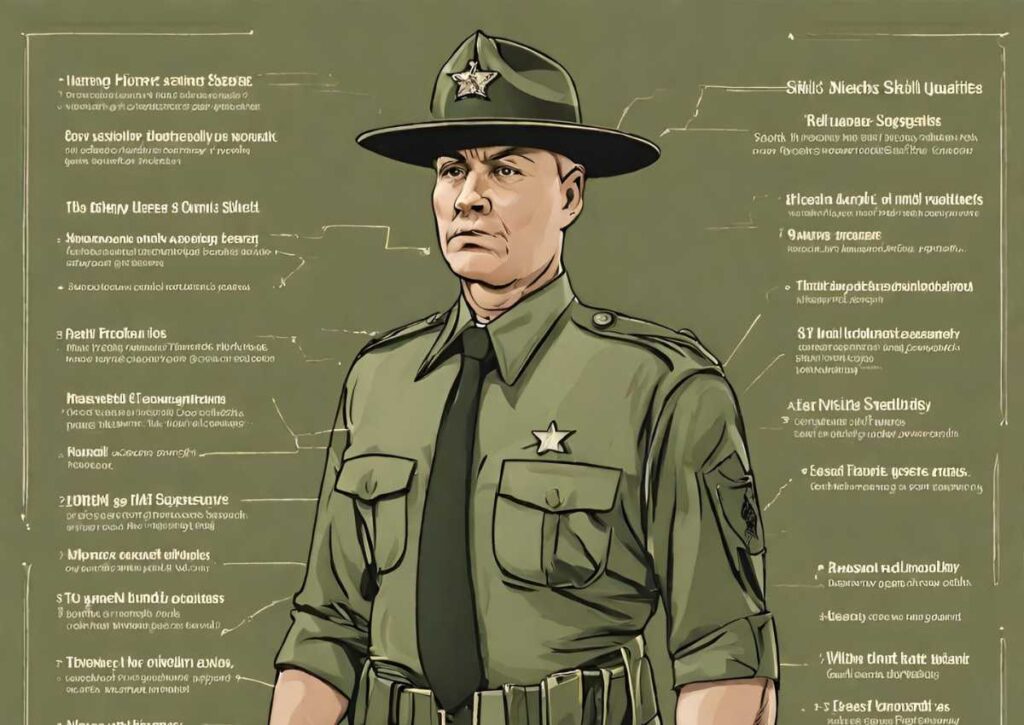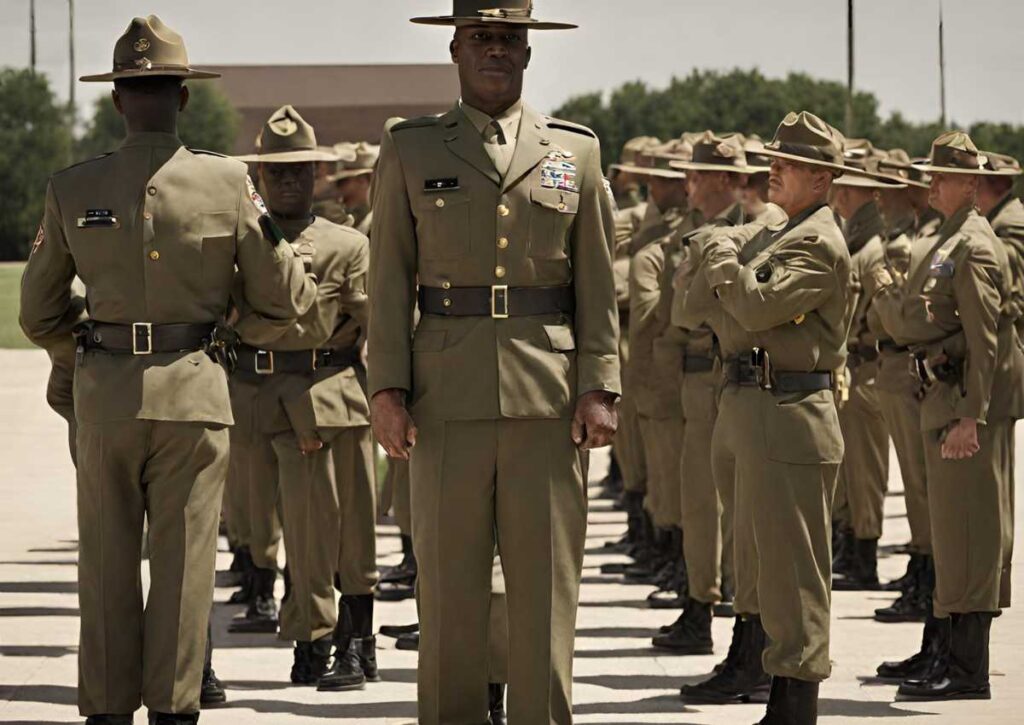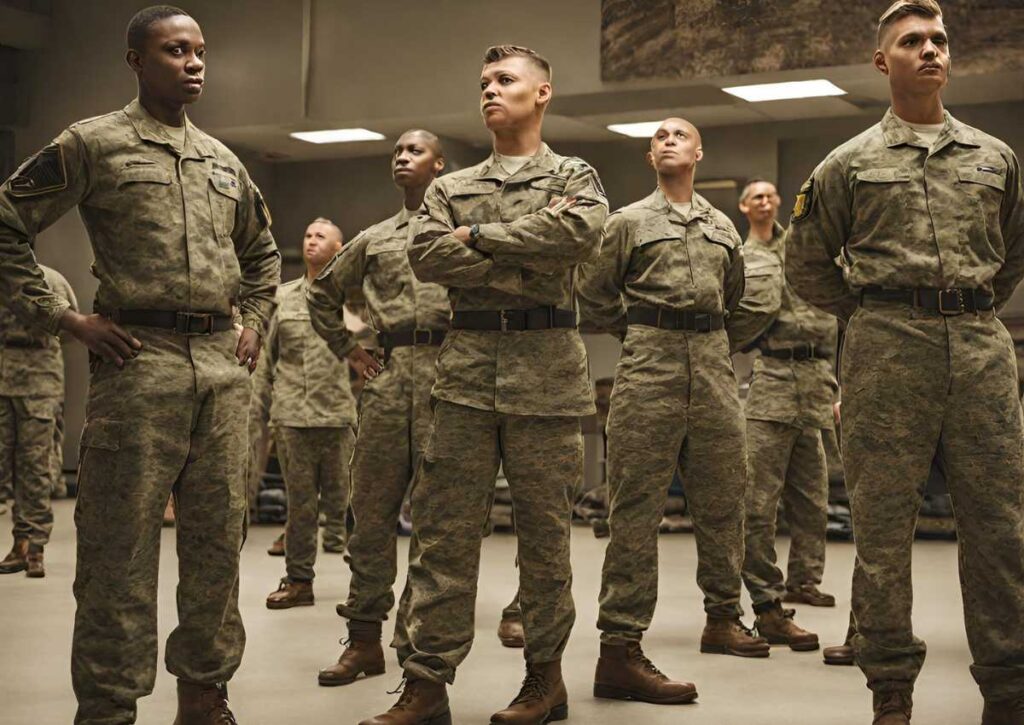Have you ever watched movies or TV shows featuring drill sergeants and wondered how to become one?
Perhaps you have a deep respect for those who serve in the military and want to take your skills to the next level.
To become a drill sergeant, you must first join the military and complete basic training.
After serving for a few years and demonstrating exceptional leadership skills, you can apply for Drill Sergeant School.
If you are accepted, you will have to go through tough training and meet strict mental and physical requirements.
Maybe you’re looking for a new career path that offers both challenge and purpose.
Whatever your motivation, becoming a drill sergeant is a noble and rewarding goal that requires hard work and dedication.
In this blog post, we’ll explore the steps you need to take to achieve this dream and join the ranks of the elite few who train our nation’s finest soldiers.
Prerequisites and Eligibility To Become A Drill Sergeant
Getting the job of drill sergeant is an honor and a challenge that takes hard work, discipline, and a strong sense of leadership.
If you’re interested in going down this career road, you need to know what you need to do first and be eligible.
We will talk about the time you have to serve in the military, the age and rank limits, and the health standards you must meet to become a drill sergeant.
Military Service Requirements
To become a drill sergeant, you must have a minimum of two years of military service, and it is highly recommended that you have combat experience.
This experience provides you with the necessary knowledge and skills to train and lead soldiers effectively. You must have a good service record and be in good standing with the military.
Age and Rank Restrictions
The age requirement to become a drill sergeant is 21 years old, and you must hold a rank between E-5 and E-8.
However, the Army Reserve and Army National Guard allow E-4 personnel to become drill sergeants.
It is worth noting that the rank requirements may vary depending on the branch of the military you serve in.
Physical Fitness Standards
Becoming a drill sergeant requires you to meet the tough physical fitness standards set by the military.
You must have a high level of physical fitness and meet the height and weight requirements.
You must pass the Army Physical Fitness Test (APFT), which includes push-ups, sit-ups, and a two-mile run. Your age and gender determine the required minimum score for each event.
Necessary Skills and Qualities

Becoming a drill sergeant in the military requires a unique set of skills and qualities.
Not only do you need to be physically fit and have a deep understanding of military tactics and procedures, but you also need to possess a variety of personal qualities that allow you to effectively lead and train others.
We will explore some of the key skills and qualities that are essential for anyone looking to become a successful drill sergeant.
Leadership and discipline
As a drill sergeant, you will be responsible for leading and motivating recruits through some of the most challenging experiences of their lives.
This requires strong leadership skills, including the ability to set clear expectations, provide constructive feedback, and lead by example.
You must also have a deep understanding of military discipline and be able to enforce rules and regulations fairly and consistently.
Communication and interpersonal skills
Effective communication is essential in any leadership role, and this is especially true for drill sergeants.
You must be able to communicate clearly and effectively with recruits, as well as with other members of the military chain of command.
You must have strong interpersonal skills that allow you to build relationships and connect with people from diverse backgrounds and experiences.
Adaptability and resilience
The military is an ever-changing environment, and as a drill sergeant, you must be able to adapt quickly to new situations and challenges.
This requires a high level of resilience, as well as the ability to remain calm under pressure and maintain focus in the face of adversity.
Teaching and mentoring abilities
Perhaps the most important skill for a drill sergeant is the ability to teach and mentor recruits effectively.
This requires a deep understanding of military tactics and procedures, as well as the ability to break down complex concepts into simple, easy-to-understand instructions.
You must also have strong coaching and mentoring skills that allow you to provide guidance and support to recruits as they navigate the challenges of military training.
The Application Process
The first step in becoming a drill sergeant is to complete the rigorous application process.
This process requires applicants to meet certain qualifications and undergo a series of evaluations to ensure they have the necessary skills and abilities to serve as drill sergeants.
We will explore the steps involved in the application process and provide valuable information to help you succeed.
Submitting the initial application
The initial application is the first step in becoming a drill sergeant. The application process begins by completing an online application on the U.S.
Army Recruiting Command website. The application requires applicants to provide personal information, such as name, date of birth, social security number, and contact information.
Applicants must provide details about their military experience, education, and training.
To be eligible for the position of drill sergeant, applicants must meet certain requirements.
These include being a U.S. citizen, being at least 21 years old, and possessing a high school diploma or equivalent.
Applicants must have completed Basic Combat Training and Advanced Individual Training, have a minimum score of 240 on the Army Physical Fitness Test, and be in excellent physical condition.
Obtaining recommendations and endorsements
After submitting the initial application, applicants must obtain recommendations and endorsements from their commanding officers and supervisors.
These recommendations and endorsements should attest to the applicant’s leadership abilities, communication skills, and overall suitability for the position of drill sergeant.
To obtain recommendations and endorsements, applicants should speak with their commanding officers and supervisors and explain their desire to become a drill sergeant.
They should ask for their support and provide them with any necessary documentation, such as copies of their military records or training certificates.
Preparing for the interview process
The final step in the application process is the interview.
This process consists of a series of interviews and evaluations to determine whether the applicant has the necessary skills and abilities to serve as a drill sergeant.
The interview process is tough and may involve multiple interviews with different officials and panels.
To prepare for the interview process, applicants should research the role of a drill sergeant and familiarize themselves with the Army’s core values and mission.
They should also practice their interview skills and be prepared to answer questions about their leadership abilities, communication skills, and experience in the military.
Applicants should also be prepared to demonstrate their physical fitness and undergo additional evaluations, such as a medical examination or a background check.
Drill Sergeant School

If you’re interested in becoming a drill sergeant in the United States Army, you’ll need to attend Drill Sergeant School.
This is a rigorous training program designed to prepare soldiers to lead and train recruits.
The school is designed to be challenging both physically and mentally, and it requires a high level of discipline and dedication to complete.
We’ll provide an overview of the training program, the curriculum and course topics, physical training and fitness requirements, and evaluation and testing.
Overview of the training program
Drill Sergeant School is an intensive course that takes place over nine weeks. During this time, you’ll learn the skills and knowledge necessary to be a successful drill sergeant.
The training is divided into three phases, with each phase building upon the previous one.
Phase one focuses on preparing you for the physical and mental demands of the program. Phase two is the academic phase, where you’ll learn the curriculum and course topics.
Phase three is the application phase, where you’ll put your new skills to the test by leading and training recruits.
Curriculum and course topics
The curriculum and course topics covered in Drill Sergeant School are wide-ranging and comprehensive.
You’ll learn about leadership, communications, physical fitness, weapons, tactics, and many other topics.
Some of the specific courses you’ll take include the Drill Sergeant Candidate Course, the Basic Non-Commissioned Officer Course, the Army Basic Instructor Course, and the Sexual Harassment/Assault Response and Prevention (SHARP) Course.
You’ll also receive training on how to train and mentor soldiers effectively.
Physical training and fitness requirements
Physical fitness is an essential component of being a drill sergeant. As such, you’ll need to meet certain physical fitness requirements to enroll in Drill Sergeant School.
These requirements include passing the Army Physical Fitness Test (APFT) with a score of at least 240, complying with height and weight standards, and passing a medical examination.
Once in the program, you’ll be expected to maintain a high level of physical fitness throughout the training.
Evaluation and testing
Throughout the training, you’ll be evaluated and tested on your performance.
This includes both written and practical exams, as well as evaluations of your leadership and teaching abilities.
You’ll need to maintain a high level of performance throughout the training to graduate successfully.
Graduation and Assignment
After completing the rigorous training and selection process, you will officially earn the title of drill sergeant.
Your hard work and dedication have paid off, and you are now ready to take on the responsibilities of leading and training recruits in the military.
The next step is to receive your drill sergeant badge and begin the assignment process.
Earning the Drill Sergeant Badge
The drill sergeant badge is a symbol of excellence and leadership in the military.
To earn the badge, you must complete the Drill Sergeant Course, a demanding 9-week program designed to teach you the skills and knowledge necessary to lead and train soldiers.
The course covers topics such as physical fitness, drill and ceremony, marksmanship, leadership, and communication.
You will be evaluated on your ability to instruct and lead soldiers in all of these areas.
Drill Sergeant Assignment Process
Once you have earned your drill sergeant badge, you will begin the assignment process. The first step is to submit your preferences for your duty station.
You can choose from a variety of locations, including Basic Combat Training (BCT) centers, Advanced Individual Training (AIT) centers, and One Station Unit Training (OSUT) centers.
Your preferences will be taken into consideration, but the final decision will depend on the needs of the military.
After your duty station is assigned, you will attend the Drill Sergeant Assignment Process (DSAP) briefing.
This briefing will provide you with all the information you need to know about your new role and responsibilities, as well as the expectations of the military.
You will also receive training on how to effectively train and lead soldiers.
Adjusting to the New Role and Responsibilities
As a drill sergeant, you will have many new responsibilities and duties.
You will be responsible for training and leading soldiers, maintaining discipline and order, and ensuring that your recruits are prepared for the challenges of military service.
It can be a demanding and challenging role, but with the right mindset and approach, it can also be extremely rewarding.
To adjust to your new role and responsibilities, it is important to stay focused and committed.
You will need to be patient and understanding with your recruits while also maintaining a firm and authoritative presence.
You should also be open to feedback and willing to learn from your experiences as a drill sergeant.
With time and dedication, you will become a skilled and effective leader, helping to shape the future of the military.
Succeeding as a Drill Sergeant

Being a drill sergeant is a challenging and rewarding career path. Drill sergeants are responsible for training and shaping the next generation of soldiers.
It is a position of great responsibility, and it requires a unique set of skills and qualities. We will discuss some of the essential skills and practices that can help you succeed as a drill sergeant.
Balancing authority and approachability
One of the most critical skills for a drill sergeant is to strike a balance between authority and approachability.
As a drill sergeant, you need to command respect and maintain discipline while also being approachable enough for your soldiers to seek guidance and support.
To achieve this balance, you need to be consistent in your behavior, tone, and communication.
You should set clear expectations and enforce them consistently, but also be approachable enough for your soldiers to ask questions or seek clarification.
Effective communication is key to achieving this balance. You should listen actively, give constructive feedback, and avoid harsh criticism.
Respect your soldiers’ feelings, show empathy, and build a rapport with them.
Staying up-to-date with military training standards
As a drill sergeant, you are responsible for ensuring that your soldiers are trained to the highest standards.
To do so, you must stay up-to-date with the latest military training standards, policies, and procedures.
To keep your knowledge and skills current, attend training courses and seminars, read military publications, and participate in professional development opportunities.
Stay informed about the latest technologies and innovations in the field of military training.
You should also seek feedback from your soldiers, superiors, and peers to identify areas for improvement and adjust your training methods accordingly.
Self-care and managing stress
Being a drill sergeant can be stressful and demanding, both mentally and physically.
It is essential to practice self-care and manage stress effectively to maintain your health, well-being, and job performance.
To manage stress, take breaks, prioritize your tasks, and practice relaxation techniques such as deep breathing, meditation, or yoga.
Seek social support from family, friends, or colleagues. Maintain a healthy diet and get enough sleep.
To promote self-care, engage in activities that bring you joy, such as hobbies, sports, or volunteer work.
Set realistic goals, celebrate your achievements, and acknowledge your strengths and weaknesses.
Conclusion
As we conclude this guide on how to become a drill sergeant, it’s important to reflect on the rewarding journey that lies ahead for those who choose this career path.
Becoming a drill sergeant requires hard work, dedication, and a willingness to lead by example. But for those who are up to the challenge, the rewards are significant.
Not only will you have the opportunity to shape the future of the military by training and mentoring the next generation of service members, but you’ll also develop skills and experiences that will serve you well throughout your entire life.
We’ll explore the lasting impact that becoming a drill sergeant can have, both on the service members you train and on your own personal and professional growth.
FAQs
How much do drill sergeants make?
Drill sergeants’ salaries vary based on rank and years of service. As of the Army’s 2021 pay scale, a sergeant with 4 years of service earns a base pay of $2,985 per month.
They also receive special duty pay of $375 per month, totaling $3,360 monthly.
Is it hard to be a drill sergeant?
Yes, becoming a drill sergeant is challenging. It demands high physical fitness, mental toughness, and leadership skills.
Prospective drill sergeants undergo a stringent selection process and an eight-week training program at the Drill Sergeant Academy.
Maintaining high performance throughout their careers is crucial.
What disqualifies you from drill sergeant?
Factors like serious disciplinary history, physical limitations not meeting fitness standards, lack of leadership ability, or failure to meet Drill Sergeant Academy requirements can disqualify someone.
Candidates need completion of Basic Combat Training and Advanced Individual Training, no adverse actions or Article 15 proceedings, and at least 24 months left on their enlistment contract.
Is a drill sergeant a high rank?
Drill sergeants are non-commissioned officers (NCOs), ranking below commissioned officers.
Despite their lower rank, they hold significant responsibility and leadership roles critical in shaping new soldiers.
Their position commands respect within the Army due to their training and leadership abilities.









